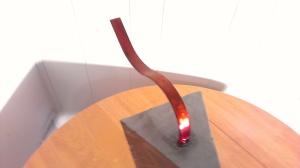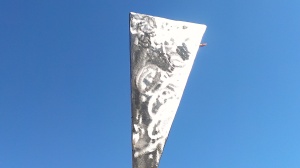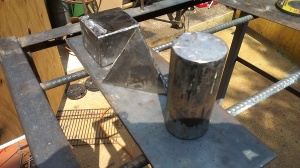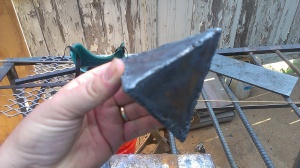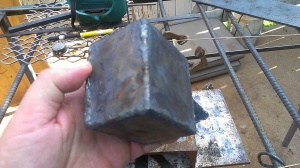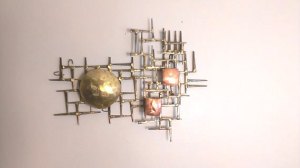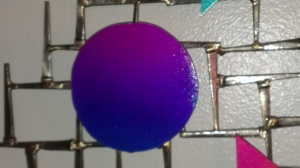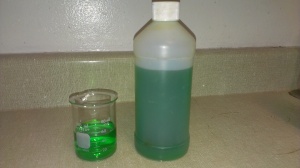
This informative blog is about making a oxidizing acidic etchant/cleaner for copper alloys from readily available materials. When working with copper, brass or bronze it is typical that the studio artist must heat said alloy to red heat to anneal it. This is a process that loosens the crystalline structure of the alloy allowing it to be easily formed and worked. After working these alloys though, they tend to work harden as the tiny crystals within the metal get packed tighter and tighter by the working and/or forming. During a typical project these repeated heating cycles build up a tough layer of metal oxides that need to removed if a shiny surface is desired.
To accomplish this task you need an acid solution. More importantly, an acid solution that is also an oxidizer able to oxidize corrosion products to a more soluble state to assist in removal. Also, an acidic oxidzer is also usefull in etching copper alloys as well creating relief patterns when suitable resists are used.
For removing fire scale from copper alloys, especially brass, can be a tough endeavor. That is because the other alloying elements present with copper in brass, namely zinc, also form oxides along with the copper oxides. Just using a non oxidizing acid such as diluted hydrochloric of sulfuric acids will leach the zinc from the surface leaving unsightly pink blemishes. These blemishes are concentration of copper that have been dezinced. This coating can be very tenacious needing abrasive mechanical removal. The traditional method to combat this was to dip the brass in a mix of concentrated sulfuric and nitric acids. Although effective, the chemicals are extremely corrosive, give off deadly fumes, and nowadays very difficult to find and quite expensive. Then there are legal aspects for obtaining, using, and storing these reagents that make the ideal completely impractical.
For etching, typically a solution of ferric chloride would be used as it is readily available at any well stocked electronics supplier. This is a metal salt that forms an oxidizing acid in solution. The disadvantage is that it only can absorb a finite amount of copper before the solution is exhausted. In this case you are left with a potentially pollution hazard that needs special treatment for disposal.
There is a chemical that is easily made from cheap and readily available materials and it can be regenerated so there never is any need for disposal issues. Whats more is that it can preform as an effective etchant and a decent fire scale remover as well. That chemical is copper II chloride. It also goes by an archaic name as cupric chloride. It is a bright emerald green poisonous compound that makes an oxidizing acid solution.
The main ingredient to start preparing a copper II chloride solution for your own use is muriatic(hydrochloric) acid. This fuming liquid is available at many home improvment, paint, swimming pool suppliers, and hardware stores. The typical concentration is 31.45%. For our use you can use about a 10% solution to start with. Stronger solutions could be used if you are working with 3% hydrogen peroxide. First you will need som copper scraps and hydrogen peroxide. Put these in a non reactive nonmetal container. Cover copper with diluted muriatic acid. Next you will add the hydrogen peroxide in small portions because of excessive fizzing. There are various strengths of peroxide on the market from 3% up to about 30%. The peroxide from the drug store is 3%. You might find peroxide at a beauty supply that is 6% to 15%. Stronger solutions of peroxide are available as a non chlorine sanitizer for pools and spas. Just remember that if you use stronger peroxide dilute your acid and be more careful with adding the peroxide as the reaction may tend to overflow the container. It is best to use a container much bigger than the solution you are working with. For the drugstore 3% peroxide just use muriatic acid in full strength or diluted to 16%(which is one part muriatic to one part water). The solution will become rich green very quickly. Leave solution time to stop bubbling overnight. Next day, pour off the clear green liquid into a non metal sealable container for storage.
If the idea of handling both peroxide and acid alarm you, there is an other way. It just takes more work and a longer time. Take some muriatic acid and dilute with equal amount of water. Add as much old tarnished brown copper as possible then let sit. After an hour or so pour off acid solution and repeat with more oxidized copper until the solution is sufficiently green. Alternatively, you can heat shiny copper until it is black/brown and dip in the acid as many times as necessary until the desired level of green is reached.






